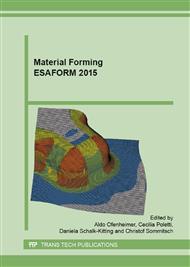p.96
p.102
p.108
p.114
p.120
p.126
p.132
p.138
p.144
Hot Deformation Behavior of a 3rd Generation Advanced High Strength Steel with a Medium-Mn Content
Abstract:
Medium-Mn steels are one of the promising candidates to achieve the desired mechanical properties in the 3rd generation of cold rolled advanced high strength steels (AHSS) for automotive applications. Their duplex microstructure consists of a ferritic matrix with a substantial amount of metastable retained austenite, which transforms to strain-induced martensite upon forming. This strengthening mechanism, well known as the TRansformation Induced Plasticity (TRIP) effect, provides the steel an excellent combination of high strength and elongation with a product of RmxA80 up to 30.000 MPa%. As hot rolling is one of the crucial steps during their production, the hot deformation behavior of Medium-Mn steels has to be thoroughly evaluated during their development stage.Therefore, the present contribution studied the hot deformation response of a 0.1 %C 5.5 %Mn steel by means of hot compression tests using a Gleeble® 3800 device. The influence of different deformation temperatures (900-1100 °C) and strain rates (0.1-10 s-1) on the stress-strain behavior was investigated. The flow curves were analyzed and corrected by the effects of adiabatic heating.Furthermore, the strain rate sensitivity m of the material was determined by evaluating stress values at different strain rates for given temperatures and strains. The m-values can be used to predict the deformation behavior of the material within the investigated range of parameters.Lastly, the hot working behavior of an alternative steel concept for a 3rd Generation AHSS with significantly lower Mn-content was comparatively investigated.
Info:
Periodical:
Pages:
120-125
Citation:
Online since:
July 2015
Price:
Сopyright:
© 2015 Trans Tech Publications Ltd. All Rights Reserved
Share:
Citation:


